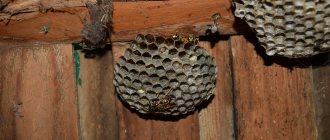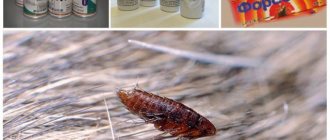Dichlorvos (DDVP) is a broad-spectrum insecticide used to kill insects both in residential buildings and in industries. It belongs to organophosphorus compounds. In the beginning, his formula was very dangerous due to the presence of toxins in it. Now they have been replaced with pyrethroids, but cases of poisoning still occur with the drug.
The main advantages of dichlorvos, which made it the most popular means of combating parasites, are the following qualities:
- fast action;
- effect on pests in all ways simultaneously: through direct contact, inhalation of vapors, ingestion;
- relative safety for people and pets;
- environmental safety - rapid decomposition;
- safety for plants, including domestic ones;
- the waiting period after treatment lasted no more than five days.
However, dichlorvos also has disadvantages; harm to humans is becoming more and more apparent with the advent of a new generation of insecticides:
- the need for a long exposure and then long ventilation of the treated premises;
- the possibility of intoxication due to organophosphorus compounds affecting the nervous system;
- risk of exposure to fumes or accidental ingestion.
Composition of dichlorvos
Let's look at the composition of the substance and try to figure out whether it is possible to be poisoned by dichlorvos and what the risks may be. The active components of this product are pyrethroid insecticides:
- deltamethrin;
- permethrin;
- piperonyl oxide;
- cypermethrin.
Additional auxiliary components of the composition are:
- aliphatic hydrocarbons;
- dimethyl sulfoxide;
- ethanol;
- preservatives.
Pyrethroids are considered substances of the third hazard class, that is, they are low toxic. Most often, the human liver copes with them on its own: it breaks them down into safe metabolites. But there are cases of poisoning for the following reasons:
- carrying out manipulations with dichlorvos without the use of protective equipment or in an unventilated, poorly ventilated room;
- children playing with unattended dichlorvos;
- poisoning of particularly vulnerable persons (children, pregnant women, pets) who remained in the treated area;
- attempts by suicides to commit suicide by swallowing dichlorvos or injecting it under the skin.
A dose of 0.5-2 g of this drug is considered fatal for humans, depending on the age, weight and health status of the victim. This clearly indicates that dichlorvos is dangerous for humans and requires a careful approach to operation.
Composition and pharmacological properties of dichlorvos against lice
The first generation powerful aerosol is no longer available. Less toxic modern broad-spectrum agents are common:
- Dichlorvos Neo is odorless. Aggressive organophosphorus aerosol contains three active components: piperonyl butoxide, permethrin, cypermethrin. Excipients: ethyl alcohol, fragrances, preservatives, stabilizers. Through the digestive system, respiratory organs, and chitinous cover, toxic components enter the body of parasites and have a nerve-paralytic effect. Insects die quickly. When treating a room, the aerosol lasts for two weeks - a prolonged effect. Consumption is minimal. The price is low compared to analogues. Does not leave marks on furniture. These factors determine the popularity of the product.
- Dichlorvos Eco. Ingredients: cypermethrin, natural pyrethrins (Dalmatian chamomile flower extract), excipients (lavender flavor). An effective, inexpensive product. The consumption is economical.
More concentrated analogs are known: dichlorvos universal, monitor lizard, terminator. They differ slightly in composition and smell. It is better not to use to combat pediculosis.
The components of organophosphorus agents can remove adult parasites, but not nits (lice eggs).
It is important to remember that any insecticide contains toxic components that are harmful to humans and pets. Choose such means as a last resort - if no other methods of pest control are available. Use with caution. Before killing lice with dichlorvos, read the rules of use and safety precautions.
Signs of poisoning
Symptoms of dichlorvos poisoning differ depending on how the substance entered the human body: through the skin and mucous membranes, by inhalation, through the esophagus.
In case of contact through the skin, the following symptoms are observed:
- tingling;
- redness;
- burning;
- swelling and itching, as with allergies.
Upon contact with the eyes, a person feels:
- pain and itching in the eyes;
- redness of the mucous membrane of the eyes;
- excessive lacrimation;
- discharge from the conjunctiva.
What happens if you inhale dichlorvos in a poorly ventilated area? If a person spends a lot of time in a closed space with dichlorvos vapor, he will soon feel the following signs:
- headache;
- dizziness, poor coordination;
- cough and runny nose;
- unpleasant sensation in the respiratory tract;
- increased body temperature up to 38, sometimes up to 39 degrees;
- nausea and vomiting, sometimes extremely strong and endless.
Entering the human body through the esophagus, dichlorvos causes the most severe poisoning, compared to entry through other routes:
- vomiting is incessant and debilitating;
- severe diarrhea;
- heavy sweating;
- decreased vision;
- suffocation;
- convulsions.
Doctors divide dichlorvos intoxication into three stages:
| Stage | Description |
| Increased arousal | It begins a few minutes after dichlorvos enters the body. A person feels an extraordinary surge of strength and, due to an excess of energy, makes incomprehensible, fussy movements, but does not control them, for example, rushes aimlessly around the room. The pressure rises, the pupils constrict, tachycardia, dizziness and migraine begin. The salivary glands work extremely intensively, a person literally drips from his mouth. |
| Loss of coordination | Starts after a few hours. The patient constantly wants to go to the toilet, but the very act of defecation or urination is painful for him. Choking occurs, tremors of the arms and legs, convulsions of the whole body, saliva no longer drips, but simply flows from the mouth. Vision deteriorates very much, a person sees everything around blurry. If treatment is not started, stupor, pulmonary edema and death will occur. |
| Paralysis | Loss of consciousness and all reflexes, paralysis of muscles and breathing. The pressure drops very strongly, bradycardia sets in. In the absence of help, a person will die in a maximum of 24 hours. |
First aid
If dichlorvos gets into your eyes:
- rinse your eyes thoroughly with water, or saline, or a two percent soda solution (1 tsp of soda for 1 cup of water);
- drip Albucid or some other medicine for eye inflammation into the eyes;
- if necessary, apply a blindfold;
- consult an ophthalmologist.
If dichlorvos gets on your skin:
- wash the affected area with water and soap or a two percent soda solution;
- Do not rub the affected skin too hard under any circumstances: this helps the poison penetrate into the deeper layers of the skin;
- remove all clothing that the person was wearing at the time he was infected with dichlorvos, as particles of poison may remain on them.
If a person has inhaled dichlorvos vapor:
- take the person out into the fresh air;
- remove all clothing that the person was wearing at the time he was infected with dichlorvos, as particles of poison may remain on them;
- the victim should rinse his mouth and nose, rinse all exposed parts of the body with water, as dichlorvos molecules may get on them;
- the victim should lie down in bed and calm down.
If dichlorvos gets into the digestive tract:
- give the victim plenty of clean water to drink;
- induce vomiting;
- give any adsorbent drugs;
- one hour or an hour and a half after the sorbent, give a laxative based on salt: magnesia, Glauber’s salt;
- It is also useful to do an enema, but only if the victim himself or someone nearby knows how to do it, otherwise the patient can be further injured;
- again give plenty of clean water or tea, jelly to drink;
- put the patient to bed and provide him with peace.
The victim should eat light natural food for several days and be sure to drink kefir to restore the intestinal microflora.
With a small amount of dichlorvos ingested, you can do without medical help, much less hospitalization. After two or three days the person recovers completely. But if a child who is not even a year old is poisoned, a doctor is definitely needed. In older children, intoxication can also develop very quickly due to their weak immunity, so for the complete safety of children it is better to seek advice from a specialist.
If an allergic person is poisoned, in addition to other measures of assistance, he should be given antiallergic medications as soon as possible. Tavegil or suprastin, antihistamine ointments for the skin are suitable if the chemical gets on it.
Treatment for Dichlorvos poisoning
If you suspect Dichlorvos poisoning, you must perform the following steps:
- If the victim has managed to inhale the substance, he should be immediately taken out into fresh air, placing him in a horizontal position;
- Clothing that restricts breathing must be removed;
- If the victim is conscious, then his mouth and nasopharynx should be rinsed with a weak soda solution. This will remove any remaining poison from the upper respiratory tract.
Important! It is forbidden to let an unconscious victim snort ammonia! In this case, he should be immediately taken to the hospital department to avoid death. The removal of toxic substances from the victim’s body can only be carried out in a hospital setting. A person’s life directly depends on this!
Treatment in hospital
The need for hospitalization is determined by the emergency doctor or hospital where the victim went. If there is such a need, the patient will be prescribed such treatment methods.
- Gastric lavage using a tube.
- In case of seizures, medications for them.
- Antidote – atropine sulfate or alox.
- Medicines for the heart, since it is under excessive stress from the poison.
- Antibacterial agents to prevent secondary infection.
- If breathing is impaired - artificial ventilation.
Consequences
Dichlorvos is characterized by the fact that its exposure causes both immediate consequences (complications) and long-term consequences.
Complications appear within two weeks from the moment the substance enters the human blood. The patient begins to suffer from:
- toxic hepatitis;
- nephropathy;
- pneumonia;
- dystrophy of the heart muscle.
Long-term consequences appear within three years from the moment the substance enters the human blood. The patient begins to suffer from:
- astheno-vegetative syndrome : disturbances in the functioning of internal organs due to poor functioning of the autonomic system;
- myeloradiculitis : simultaneous inflammation of the human spinal cord and spinal roots;
- polyneuritis : diseases of the peripheral nervous system.
For pregnant women, dichlorvos poisoning is doubly dangerous. If it occurs during an early period, the fetus may freeze. If during the last months, the fetus may develop developmental abnormalities or even the death of the unborn child.
Prevention
How to use dichlorvos to eliminate the risks of poisoning? There are several rules that will help you avoid unpleasant consequences.
- All manipulations with dichlorvos should be carried out only in special clothing and protective equipment (gloves, respirator).
- Both during and after treating the room with dichlorvos, it must be well ventilated.
- Under no circumstances should pregnant women and allergy sufferers manipulate dichlorvos.
- After finishing the treatment of the room, no people or animals should be in it for at least four hours, preferably six hours.
- After finishing the treatment, all working surfaces must be washed or at least wiped thoroughly.
- You should buy dichlorvos only in stores, and not from individuals, who can make it themselves, without taking into account sanitary standards.
- Dichlorvos should be stored out of the reach of children.
- It is best not to carry out any actions at all with dichlorvos, but to leave disinfestation to SES workers.
Nevertheless, the modern formula of dichlorvos is so improved that poisoning with this chemical can only be caused by particularly improper use, either intentionally or by people with very poor health.
How to prevent poisoning
- To protect yourself, your family and pets from Dichlorvos poisoning, it is enough to follow simple rules for working with chemicals:
- Keep insecticides out of the reach of small children and animals.
- Do not place insecticide spray cans in food cupboards,
- When working with the drug, use a protective gown, goggles, gloves and a respirator,
- Do not treat the premises if there are other people or animals in the premises,
- Do not spray the aerosol in rooms without access to fresh air,
- After treatment, thoroughly ventilate the previously treated rooms, wash all surfaces, including floors, with a soda solution or soapy water.
I don't have pets, so if I need to spray my house with an insecticidal spray, I choose days when everyone in the household goes to work and school. Not forgetting my unpleasant condition after working with Dichlorvos several years ago, I always use long sleeves, rubber gloves, glasses and a tight bandage covering my mouth when processing. I recommend covering your hair with a scarf or cap, as particles of the substance also settle on them. Considering that in the morning my family leaves the house at 8 o’clock in the morning, by the time they return at 5 o’clock in the evening I have time to carry out the treatment, wash the clothes used in the process, ventilate well and wash the treated room. Convenient and safe.
Dichlorvos allows you to quickly and effectively destroy many types of insect pests. If the drug is used correctly, the risk of insecticide poisoning is negligible, so it is very important to follow safety precautions when treating premises. If you have additional information on the topic of our article, be sure to share it in the comments below. Be healthy!











